(note: the alternatives to viasat section of this article was updated for 2023 on 01 Oct 2023)
If you are a subscriber of Sailing SV Delos YouTube channel you may have seen their recent episode showing their new high-speed satellite Internet installation. In the video, Delos crew are joined by a team from Viasat to install a satellite broadband internet system. They show Brian installing a little rack of networking equipment below decks and then the team hoisting a large dome onto the center of their solar arch. Finally, they run a speed test with amazing speeds and then they stream their own Youtube videos via satellite. Amazing Right? We all want that! And you may be wondering what they actually installed, and whether it’s something you can get also? Read on for the details!
Who is Viasat?
Viasat is one of several satellite broadband providers operating with geostationary satellites. You may also be familiar with HughesNet. Both Viasat and HughesNet offer satellite Internet for homes and businesses as an alternative to cable, fiber, and DSL. In the maritime world, you may also be familiar with Inmarsat and KVH, both of which also offer satellite broadband via geostationary satellites for boats, yachts, and ships. All of these providers offer a service referred to as VSAT (Very-Small Aperture Terminal). KVH sometimes calls their own service mini-VSAT. The “Very-Small” refers to the dish size being less than 9ft in diameter. 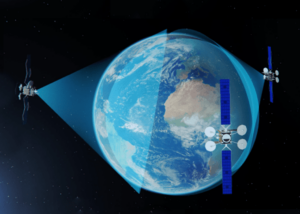 For reference, geostationary satellites are orbiting at ~22,000 miles of altitude over the Earth’s surface and follow the earths spin, so they appear from a viewer’s perspective to always be in the same place in the sky. From a fixed point like a house, you can point an antenna at the satellite, and it will stay pointed at the satellite more or less forever without having to adjust it. VSAT systems typically operate in the Ku- or Ka-Band of radio frequency, from 10-15Ghz or 17-31Ghz way higher frequency than wifi, cellular, and slower satellite broadband systems such as Iridium (Iridium operates on L-Band, ~1.6Ghz)1. There are advantages and disadvantages to low and high frequencies, but generally you need higher frequency to support higher speeds. Note: DirecTV and Dish Network satellite TV are similar, they just broadcast using a different radio technology. Viasat has also recently been deploying their services on airplanes, gradually replacing the older, slower, land-based, GoGo Inflight internet service. Since it is satellite based, Viasat service works on more flight routes and can also provide more bandwidth to each plane.
For reference, geostationary satellites are orbiting at ~22,000 miles of altitude over the Earth’s surface and follow the earths spin, so they appear from a viewer’s perspective to always be in the same place in the sky. From a fixed point like a house, you can point an antenna at the satellite, and it will stay pointed at the satellite more or less forever without having to adjust it. VSAT systems typically operate in the Ku- or Ka-Band of radio frequency, from 10-15Ghz or 17-31Ghz way higher frequency than wifi, cellular, and slower satellite broadband systems such as Iridium (Iridium operates on L-Band, ~1.6Ghz)1. There are advantages and disadvantages to low and high frequencies, but generally you need higher frequency to support higher speeds. Note: DirecTV and Dish Network satellite TV are similar, they just broadcast using a different radio technology. Viasat has also recently been deploying their services on airplanes, gradually replacing the older, slower, land-based, GoGo Inflight internet service. Since it is satellite based, Viasat service works on more flight routes and can also provide more bandwidth to each plane.
What equipment does it require?
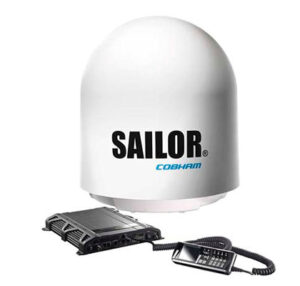 VSAT services in general, and Viasat is no different, require a relatively large dish antenna that points at the satellite at all times. For boats, this means a satellite dome with a dish inside that uses gps sensor, gyros and motors to stay pointed in exactly the right direction at all times as the boat or ship moves, pitches, rolls, tacks, etc. at sea. These dishes can be as small as 15 inches in diameter, but the most common sizes are actually closer to 1 meter. The dome installed on SV Delos is a Sailor 600 weighing about 50kg as quoted by the installer. “Sailor” is a series of marine antenna systems made by the company Cobham2, and the 600 model has a dish size of 65cm (25.5 inches) in diameter (that’s the size of the moving dish inside the dome, the overall dimensions of the dome are a bit larger). Viasat operates on the higher Ka-Band frequency. For reference, this is the same frequency band that SpaceX Starlink and other upcoming satellite Internet constellations plan to use. The downside of higher frequency is the need for larger antennas and/or higher power transmitters as higher frequencies go shorter distances compared with lower frequencies, all other things being equal. Ka/Ku Band is also more susceptible to heavy weather/rain interference compared with lower frequencies.
VSAT services in general, and Viasat is no different, require a relatively large dish antenna that points at the satellite at all times. For boats, this means a satellite dome with a dish inside that uses gps sensor, gyros and motors to stay pointed in exactly the right direction at all times as the boat or ship moves, pitches, rolls, tacks, etc. at sea. These dishes can be as small as 15 inches in diameter, but the most common sizes are actually closer to 1 meter. The dome installed on SV Delos is a Sailor 600 weighing about 50kg as quoted by the installer. “Sailor” is a series of marine antenna systems made by the company Cobham2, and the 600 model has a dish size of 65cm (25.5 inches) in diameter (that’s the size of the moving dish inside the dome, the overall dimensions of the dome are a bit larger). Viasat operates on the higher Ka-Band frequency. For reference, this is the same frequency band that SpaceX Starlink and other upcoming satellite Internet constellations plan to use. The downside of higher frequency is the need for larger antennas and/or higher power transmitters as higher frequencies go shorter distances compared with lower frequencies, all other things being equal. Ka/Ku Band is also more susceptible to heavy weather/rain interference compared with lower frequencies.
How much power does it take?
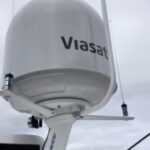
The high frequency combined with gyro-stabilization of the dish means that a VSAT system like the Sailor 600 can use 200-400 watts when it’s in active use. The rougher the seas, the more power it will consume. If you left it running all day and night you might be consuming as much as 7kwh per day. Of course, you can shut it down when you aren’t using it to save power but if you need active phone service all the time, and your VSAT system is your only satellite phone, then you’d need to leave it on for that to work. Power usage does vary with how it’s being used, when it’s not moving or transmitting the consumption is considerably lower.
How fast is it?
Typical VSAT systems offer speeds between 1mbps and 40mbps download speeds. In the SV Delos video, they showed a speed test of over 120mbps download speed which is very impressive and an upload speed of about 4.5mbps. This speed test result shown on video seems to be a marketing tactic by Viasat since their own website shows speeds up to 50mbps, and once you dig in to their airtime plans you will see that most are in the 15mbps download speed range. Even at 15mbps though, you can do a ton of things like multi-user video conferencing, HD video streaming and more. The average home in the US gets ~60mbps of download speed and 5mbps of upload speed3, so you can see that Viasat is offering speeds similar to the average residential broadband service. As of 2023, Viasat is offering unlimited usage plans with up to about 50mbps download and 5mbps upload, but those speeds are not guaranteed.
But bandwidth is not the only factor.
As with any satellite internet solution, latency is going to be affected by the altitude of the satellite, and geostationary satellites are at the high end of altitudes used by satellites. Expected latency is ~700ms (as quoted by Viasat in the Delos video). This is the amount of time it takes for a piece of information to go from the user to the satellite, back to ground, then back from ground to the user via satellite (ie: a round trip). This is directly related to the distance geostationary (GEO) satellites sit above the earth. In comparison, a typical home cable internet connection will offer latency of less than 30ms. Low-Earth orbit (LEO) satellites like Iridium will have latency of ~100ms, and future LEO constellations (ie: OneWeb, Starlink, etc) may actually achieve ~30ms like land based networks, but this is still a work in progress. For general web browsing, video streaming, downloading, uploading, etc. latency makes little difference to average users. But online gaming and other highly interactive services will suffer somewhat or be completely unusable depending on the software/service’s sensitivity to latency. As of 2023, Starlink is online and operating globally. Starlink service is compelling for a number of reasons but depending on the user and amount of data they use, Viasat may still be a good option as they provide unlimited data usage for a flat fee in the oceans, a feature that Starlink charges extra for on a per-GB basis. More on Starlink below..
Okay, but what does it cost?
The old saying “you get what you pay for” is pretty accurate here, though there is a difference between up-front costs and ongoing costs when it comes to satellite broadband for boats. My typical advice to customers is the more you are willing to invest in the hardware, the faster and cheaper the usage becomes. This is not a perfect rule but it’s pretty close to reality. True VSAT hardware starts at ~ $25K (which would include the Sailor 600). When you compare that with other satellite hardware such as Iridium ($1K-8K), Inmarsat ($3K-15K) you certainly spend more, but the speeds you get from VSAT are orders of magnitude higher. Also, hardware is an investment in the boat and/or your business, depending on why you need/want high-speed internet aboard. For business use you can depreciate the hardware as a business asset and it’s not dissimilar to investing in a good watermaker, or generator, or whatever else you may be already spending thousands of dollars on to equip your boat.
But hardware cost is not everything
There is another benefit of VSAT over other satellite options, the airtime plans are different. With every smaller/slower/cheaper satellite option on the market, the data usage is metered. Meaning you pay monthly for some amount of included data usage, and then pay extra if you use more in a given month. If you use a tiny amount of data, then okay, but if you use a lot of data, you can end up paying through the nose. For those systems, the speed is generally limited by the satellite network and/or the hardware you purchased, not by some arbitrary limit associated with your monthly plan.
With VSAT it’s the opposite. You generally pay for a minimum speed guarantee with a higher maximum possible speed, and those guarantees determine your monthly ongoing costs, and your actual usage is unmetered/unlimited.
So you can stream to your hearts’ content, upload video footage, or Skype with friends and family from the middle of the ocean, and your bill will always be the same every month. And IF you are a heavy user, you will actually pay LESS for your service than with other satellite systems. There are performance limits related to hardware, but those limits are pretty high, and generally higher than the airtime plan you may be willing to pay for. For example comparison: With Iridium Certus (a low-earth orbit, L-Band satellite service), you get 700kbps (0.7mbps) download speeds and a 10GB monthly data plan will run about $26004. But on a VSAT plan you can get approximately the same speeds as Certus, but with completely unlimited usage for $1000/month, or 3mbps (3000kbps) download for ~$2400/month. Or a minimal speed plan (which is still fast enough to browse the web, upload and download files, etc) for just $500/mo, still providing unlimited usage. Viasat’s own airtime offerings are tailored toward the higher end market. You will spend ~$25K for a Sailor 600 and then between $1000 and $3000/mo for unlimited data at speeds up to 50mbps5. These new plans are tailored toward leisure yachts with small crews (couples, families, etc), as you might imagine. Unfortunately, Viasat’s coverage map shows they have limited coverage in the oceans currently, though wide range coverage is coming soon6 (2024 timeframe it appears7) as they deploy another set of geostationary satellites. As of 2023, Viasat coverage is good for USA and the Caribbean including the West and East coasts of the USA.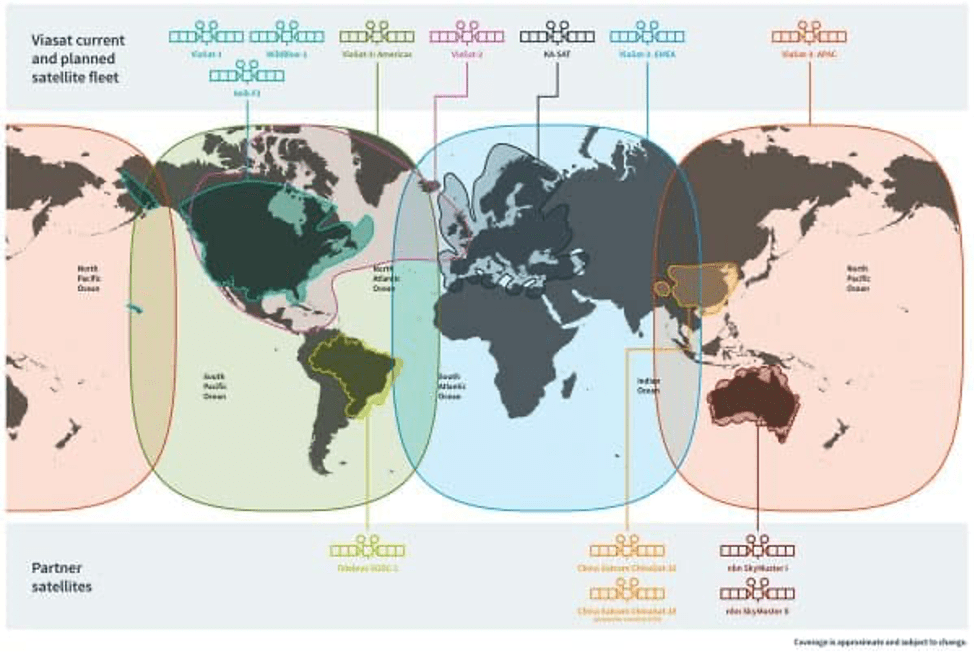
Wrapping things up…
Here’s the net-net:
1.) If you have a 43ft or larger boat,
2.) Are willing to invest about $25K or so into communications hardware,
3.) Commit to at least $500/month in service fees,
Then, you can get nearly global, unlimited, web browsing from your boat.
If you need video streaming, multi-user Skype video teleconferencing, etc. then be prepared to spend between $1000 and $2500/Month.
Note: If you don’t have the upfront capital to invest, you can also lease hardware as part of your airtime plan as an option.
Done! – Solved! — Broadband internet is available now from a variety of VSAT providers including Intelsat, Viasat, Inmarsat GX, Aura, Maverick, ITCGlobal, and Telenor.
Wondering if Viasat Maritime service is right for you?
Cheaper or Smaller Alternatives to VSAT
Let’s say you don’t have a large enough boat to support a 90-lb 32-inch satellite dome. Or you don’t have the capital to invest (or don’t want to invest that much) into VSAT hardware, what other options are there?
SpaceX Starlink

You can go with SpaceX Starlink which uses all new ku-band low-earth orbit technology and offers very high speeds and low-latency with hardware that costs between $600 and $2500. It’s lightweight, less expensive, and works well for most people. Airtime plans start at just $150/month, with unlimited use at the lowest network priority, however ocean and in-motion use have additional costs. See our Starlink plan matrix for more details on how the plans work.
Sea-Tech also offers a number of accessories designed to enhance Starlink service including mounting and networking technology as well as Narwhal Wi-Fi Onboard systems which integrate one or more Starlink units and 5G cellular into a combined seamless onboard Wi-Fi experience.
In comparison to Starlink, Viasat service is unlimited with ocean and in-motion use included for a flat fee. However the Viasat hardware is larger and more expensive.
Starlink Benefits:
- Much lower cost hardware
- Unlimited plans for coastal use
- Global service
- High speeds
- Low latency
- Easy install
VSAT Lite
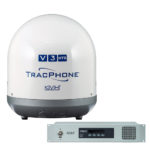
You can go with KVHs TracPhone V30 which uses the same VSAT technology and offers speeds as high as 6mbps download and 2mbps upload in a $12K 15-inch dome. It’s lightweight, less expensive, and works well for most people. Airtime plans start at just $99/month, with 200MB (not GB) of data included and then $1/MB for anything over 200MB in a month. Data overage rates can get as low as $0.50/MB which means 4GB of data will cost about $2000.
KVH Mini-VSAT Benefits:
- Lower VSAT hardware cost entry point
- Lower Monthly Service Entry point
Maritime BGAN (Inmarsat Fleet Broadband/Fleet One)
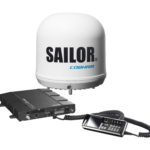
Moving out of VSAT altogether we are left with a few more traditional choices. Inmarsat operates their own fleet of geostationary satellites running on L-Band (~1500Mhz) offering global (except the poles) coverage with speeds up to 432kbps (~0.4mbps). Equipment costs run $2-15K depending on the data speeds you want (150kbps, 284kbps, or 432kbps). Airtime can run from as little as $60/month (with 10MB of data) to several thousand dollars per month for 1GB to 40GB of data. Since Fleet One/FleetBroadband uses geostationary satellites, the equipment still uses gyro stabilized domes, but they are generally smaller than VSAT domes at 11in to 27in diameter.
BGAN Benefits:
- Variety of hardware cost options as low as $2500.
- Worldwide coverage
- Fast enough for email, weather, downloads, uploads
Low-Earth-Orbit (Iridium Certus)
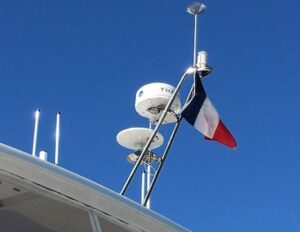 On the complete opposite spectrum from high-altitude geostationary satellites, Iridium operates a constellation of 66 satellites (plus spares) constantly orbiting the entire earth at ~500miles (vs 22,000 miles) altitude. Like BGAN, Iridium operates on relatively low L-Band frequency. Because there is at least one Iridium satellite visible to every point on earth at all times, and Iridium satellites can route information through other satellites in the constellation, Iridium offers the only 100% global connectivity service in the world. With the new satellites launched in 2018, replacing the originals that went online almost 20 years ago, Iridium offers a new higher speed data service called Certus. Certus equipment costs ~ $4-8K but when compared to Inmarsat and VSAT equipment it is more compact, lighter, uses less power, and has no moving parts. You can install a Certus terminal on practically any vessel.
On the complete opposite spectrum from high-altitude geostationary satellites, Iridium operates a constellation of 66 satellites (plus spares) constantly orbiting the entire earth at ~500miles (vs 22,000 miles) altitude. Like BGAN, Iridium operates on relatively low L-Band frequency. Because there is at least one Iridium satellite visible to every point on earth at all times, and Iridium satellites can route information through other satellites in the constellation, Iridium offers the only 100% global connectivity service in the world. With the new satellites launched in 2018, replacing the originals that went online almost 20 years ago, Iridium offers a new higher speed data service called Certus. Certus equipment costs ~ $4-8K but when compared to Inmarsat and VSAT equipment it is more compact, lighter, uses less power, and has no moving parts. You can install a Certus terminal on practically any vessel.
Certus Benefits:
- The only 100% global satellite network
- The fastest L-Band satellite Internet service (700kbps currently)
- Cheaper than FleetBroadband (BGAN)
- The lightest/smallest/lowest power consumption web-capable satellite Internet terminal
References:
- https://www.esa.int/Applications/Telecommunications_Integrated_Applications/Satellite_frequency_bands
- https://www.cobham.com/communications-and-connectivity/satcom/satellite-communication-at-sea/ku-band-maritime-vsat/
- https://www.telecompetitor.com/latest-national-broadband-data-from-fcc-finds-median-u-s-internet-speed-of-60-mbps/
- Iridium Certus Airtime
- Viasat Charter Yacht Service Plans
- https://maritime.viasat.com/coverage.html
- https://www.viasat.com/news/going-global
Data Volume Terms: (storage or consumption of data)
- Byte = a unit of data equal to 8 bits (a Byte is the amount of data it takes to store 1 alphanumeric character)
- (KB) KiloByte = 1 thousand Bytes
- (MB) MegaByte = 1 million Bytes
- (GB) GigaBytes (1 billion Bytes)
Data Speed Terms: (the rate of data transfer)
- milliseconds (ms) used in reference to latency, the time it takes for information to be transferred between two points (round trip)
- 1 (bps) bit per second (number of bits transferred in 1 second, 1 bit is 1/8th of a byte)
- 1 (kbps) kilobit per second (1000 bits transferred in 1 second, ~ 125 bytes per second or 450KB per hour)
- An Iridium Go or Iridium handheld phone transferrs at 2.4kbps, ~ 1MB per hour)
- A Pactor 4 HF Radio Modem transfers at !
- 1 (mbps) megabit per second (1 million bits transferred in 1 second, ~ 125 KiloBytes (KB) per second or 450MB per hour)
Note: pay attention to the case of b (bit) and B (Byte). Though a lot of people mix the cases inaccurately.

